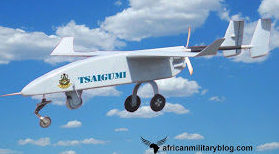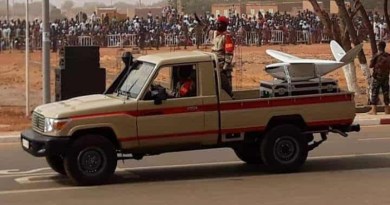Nigerian military drones (UAV): current Army, Air Force, and Navy UAV inventory
Nigerian military unmanned aerial vehicles (UAV) also called “drones” has played a significant part in tackling insecurities in the country.
The war in Nigeria’s northeastern region have shown that acquisition and rapid dissemination of intelligence, surveillance, and reconnaissance (ISR) information is an essential factor in achieving a decisive success in conflicts.

It is a well known fact that military campaigns benefits greatly from the ISR and clandestine strike capabilities offered by unmanned aerial systems.
UAVs (drones) can be used for surveillance, air strike, and covert reconnaissance, and are increasingly appealing to African militaries facing security challenges, either from terrorists, bandits, or Armed militants.
An overview of Nigerian military drone (UAV) capabilities
Nigeria is the only country in sub-Saharan Africa to operate armed unmanned aerial vehicle (UAV) and to have used them in combat. There are several UAVs in Nigeria’s inventory.

In early 2011, the absence of a credible operational UAV and other ISR assets hindered the Nigerian military’s capacity to confront and contain the Boko Haram insurgency. These capacity deficiency pushed the decision for the federal government to alllow Britain, France and Israel deployed special forces, advanced ISR assets and fixed wing aircraft during the search for the Chibok schoolgirls kidnapped by Boko Haram.
Nigeria’s local drone development
It is often difficult to assess Nigeria’s drone development programs and capabilities due to the unavailability of official data.
However, the importance of having an unmanned aerial vehicle capability particularly as Nigeria is neck-deep in a counter-terror warfare has thrust some UAV projects into the limelight.

Also, to supplement it’s drone (UAV) fleet, and increase self-reliance, Nigeria started developing its own UAVs. The first Nigerian locally made drone is the Amebo UAV and it was quickly followed by the Gulma UAV. Both were built upon the design of the Israeli supplied Aerostar UAV. After that, the Tsaigumi UAV was introduced as a follow up to the Gulma drone.
Recent developments in the Nigerian military drones (UAV) sector
Besides building UAVs, Nigeria also has its own UAV pilot training capability, the 401st Flying Training School based in Kaduna.
UAV trainings are conducted using the Chinese-made Mugin commercial UAVs for initial training however, for advanced training, the Tsaigumi and Gulma tactical UAVs are used.
Nigeria’s first in-country trained UAV pilots completed training after clocking nearly 100 flying hours on the CH-3A in 2018.
Nigerian Army on October 7, launched a UAV Command which will deliver responsive, persistent and precise UAV capabilities to achieve the NA’s mission.
The new UAV command will raise, train and sustain a UAV force which will deliver precise and timely Air Imagery Intelligence.
Nigerian military drones (UAVs): the list.
Nigerian Air Force UAVs
- Tsaigumi drone
- Amebo drone
- Gulma drone
- CH-3A UCAV
- Star Tiltrotor
- ADS Aerostar UAV
- VTOL fixed wing UAV
- Mugin commercial UAV
- RQ-11 Raven Unmanned Aerial Vehicle
Nigerian Army UAVs
- DJI Phantom
Nigerian Navy UAV (drone)
- ADS Aerostar
Nigerian UAVs under construction or testing
- Star Tiltrotor
- Ichoku hand-launched uav
Future UAVs acquisition
- Yahbon Flash-20 UAV
- Textron Aerosonde AAI VTOL UAV
- Schiebel Camcopter S-100
- PD-1 UAV
- CH-4 UCAV (possible)
Nigerian Air Force Drones (UAV)
Nigerian Air Force Aerostar Unmanned Aerial Vehicle (UAV)
The Aerostar UAV is Nigeria’s first operational drone, nine Aerostar UAVs were purchased in 2006 from Israeli’s Aeronautics Defense Systems (ADS), the Aerostar UAVs were primarily intended to be used for maritime patrol, as well as ISR during the Niger Delta crises, but the insurgency ended in 2008.

The ADS Aerostar UAV has a 14 hours operational endurance, and is equipped with Controp’s Dual-Sensor Stabilized Payload DSP-1, providing day/night surveillance coverage.
Although today most of the airframe is no longer airworthy as a result of negligence, and has been mothballed and stowed, the Aerostar UAV was used as a testbed for the new Amebo and Gulma drones.
Nigerian Air Force CASC CH-3A UAV
Nigerian Air Force received five Chinese-made CASC CH-3A armed tactical UAV, which was delivered in 2014. The type is Armed with AR-1 missile and what may have been a guided bomb. The NAF has since announced the use of the CH-3A in air strikes against ISWAP and Boko Haram.
The Ch-3 drones are armed with the AR-1 surface to air missile.

Nigerian Air Force Gulma drone (UAV)
Constructed by the Nigerian Air Force, the Gulma drone bears an external resemblance to the Aerostar and was first unveiled in 2013. It was used as a testbed to gain experience in UAV technology and eventually evolved into the more advanced Tsaigumi.
There are four cameras on board. A Gimbal camera below the Fuselage, a GoPro 3+ on the Horizontal Stabilizer, a GoPro 3 on the left wing, and a GoPro 2 on the bottom of the fuselage, just behind the Gimbal Camera.
The type is useful in aerial imaging/mapping, telecommunications and weather monitoring. It also undertake roles like news coverage, environmental monitoring, and oil and gas exploration.

Amebo drone
The Amebo drone was a joint project between the Air Force and Cranfield University UK. It preceded the Gulma drone, and was used as a prototype to test UAV technologies.
The Amebo UAV can fly at 3000 feet, and remain airborne for four hours using petrol.

The Amebo drone is also used to enhance internal security through the provision of real time information when deployed in crisis-prone areas.
Tsaigumi Drone
The Tsaigumi UAV was first unveiled in February 2018 and is intended for tactical surveillance. It was designed with assistance from Portuguese company UAVision. The NAF produced the airframe, UAVision provided the avionics suite and telemetry equipment.
The new Tsaigumi UAV was built by the Nigerian Air Force aerospace engineers and was unveiled on February 15th at the Nigerian Air Force Base Kaduna. Tsaigumi means ‘surveillance’ in the local Hausa dialect.

RQ-11 Raven Unmanned Aerial Vehicle
The RQ-11 Raven is a lightweight unmanned aircraft system (UAS), designed for quick deployment by dismounted infantry troops.
In 2015, a video surfaced online showing the Nigerian Air Force personnel operating what looks like an RQ-11 Raven UAV.
Mugin commercial UAV
The Nigerian Air Force is using the Chinese-made Mugin commercial UAVs for initial training. The Mugin fixed wing UAV is capable of carrying a wide variety of payload configurations and offers extended flight times.

VTOL fixed wing UAV
An unknown vertical take-off and landing unmanned aerial vehicle was displayed by the Nigerian Air Force in June this year.
The unknown VTOL UAV has a pusher propeller configuration which makes it capable of forward flight. It also has an external resemblance to the Ukraine made PD-1 VTOL UAV soon to be delivered to the NAF.
Nigerian Navy drones (UAV)
Nigerian Aerostar UAV
In 2019, The Nigerian Navy (NN) said drones [unmanned aerial vehicles; UAVs] and helicopters were used for surveillance of Nigerian National Petroleum Corporation (NNPC) pipelines, although it didn’t state the type of drone used, which suggests that at least some of the Aerostar UAV is active.
Nigerian Army drones (UAV)
Nigerian Army Dji Phantom Drone
The Nigerian army’s 32 Artillery Brigade of the Owena Barracks in Akure procured two DJI Phantom 4 commercial grade drones for use in combating kidnapping and banditry in the region.

Nigerian UAVs under construction or testing
Nigerian Air Force Star Tiltrotor UAV
The Nigerian Air Force during the 47th convocation ceremony of the Air Force Institute of Technology (AFIT) Kaduna on, 27 July 2018 exhibited the Star tilt-rotor unmanned aircraft which takes off vertically and can go up to five kilometers for aerial surveillance. It also has aerial bombardment capabilities, by being fitted with a 250 kg drop bomb.

Ichoku hand-launched UAV
The NAF has announced that it is working on an armed UAV, known as Ichoku, although progress on this project remains unknown.
It is believed that the Ichoku UAV is a hand-launched loitering unmanned system for dismounted infantry.
Nigerian military Future UAVs acquisition
Yabhon Flash 20
Nigeria is acquiring Adcom Systems Yabhon Flash-20 unmanned aerial vehicles (UAVs) from the United Arab Emirates.
The Yabhon Flash 20 UAV is about 1.5 tonnes maximum take-off weight. It can fly for 60-70 hours and is equipped with a gimbaled camera. Comparatively, it is the smallest of Adcom Systems’ UAVs.
Textron Aerosonde AAI VTOL UAV
The Aerosonde fixed wing AAI VTOL UAV is designed for simultaneous day/night full-motion video, communications relay, signals intelligence. It can operate on land and sea environment.
AAI Corp., a subsidiary of Textron Systems, was awarded a contract to supply the Aerosonde Mk4.7 unmanned aerial system to both Nigeria and Uganda.
The contract announced by the Pentagon on May 8 involves supplying three Aerosonde Mk4.7 UAV systems with spare parts, logistics support, new equipment training, and two field service representatives worth $25,610,000 firm-fixed-price to Nigeria.
Schiebel Camcopter S-100
In February 2019, Austrian company Schiebel demonstrated its Camcopter S-100 to representatives of the Nigerian Civil Aviation Authority, the Nigerian Air Force, the Nigerian Navy, the Nigerian Army.
“We were approached by one of our clients to carry out proof of concept BVLOS trials in Nigeria with a proven, reliable UAS that could safely carry the client’s payload,” said Tudor Moss of Aerial Robotix.
UkrSpecSystems PD-1 UAV
The Nigerian Air Force is expecting the delivery of three PD-1 Unmanned Aerial Systems (UAS), according to the 2021 budget breakdown released by the Budget office of the Federation (BoF).
The NAF is expecting to receive the PD-1 UAS before the end of this year to join the fight against insurgency in the region.
People’s Drone PD-1 unmanned aerial system (UAS) is manufactured by UkrSpecSystems, a UAS producer based in Ukraine.
The PD-1 Unmanned Aerial System is equipped with gas powered fixed-wing UAV, EO/IR camera system, data links and ground control station. The UAV’S endurance is up to 10 hours with 8 kg payload, it can perform varieties of missions like surveillance, aerial photography, agriculture, search and rescue and public safety applications.
The UAV features fixed-wing design with winglets angled upwards. Its tail section comprises two control surfaces arranged in inverted V-shape configuration, which reduces parasitic drag. The basic version comes with USG-202 electro-optical/infrared (EO/IR) gimbal payload, consisting of a full high-definition 30x Sony EV7500 day camera and a high-quality thermal imaging camera. The EO/IR cameras allow for identification, detection and tracking of targets both during day and low-visibility conditions.
CASC CH-4 (possible)
The Nigerian Air Force is expecting a new haul of eight Chinese-made unmanned combat aerial vehicles before the end of this year. The new drones, expected to be the CH-4 combat UAV will complement the four CH-3 Rainbow Armed UAV already in service with the Air Force.



